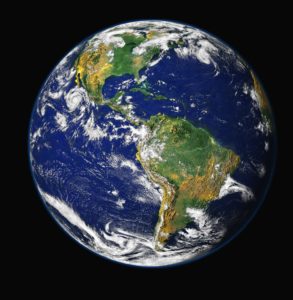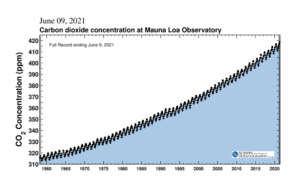 Carbon dioxide levels in the atmosphere reached a new high in May 2021 - 419 parts per million (ppm). This monthly average is the highest level in more than 4 million years! Yikes! (By the way, last year the highest level ever recorded occurred in May 2020.) Well... we topped that number this year.
Carbon dioxide levels in the atmosphere reached a new high in May 2021 - 419 parts per million (ppm). This monthly average is the highest level in more than 4 million years! Yikes! (By the way, last year the highest level ever recorded occurred in May 2020.) Well... we topped that number this year.
The carbon dioxide levels slightly fluctuate daily (they are measured at the Mauna Loa Observatory). But over the years they have been rising (an average of 2.37 ppm per year in the last decade), and each year the concentrations of carbon dioxide in the air are enough to set a new record. Each year more carbon dioxide (a greenhouse gas) piles up in the atmosphere and oceans, where it remains for thousands of years.
This is of concern not just because the earth is warming (resulting in more extreme weather, wildfires, drought, flooding), but also what higher and higher carbon dioxide levels might do to our thinking processes (thinking gets worse at high levels - think of a stuffy room where it's harder to think). Yes, this is climate change.
Pieter Tans, a senior scientist with NOAA’s Global Monitoring Laboratory said:
“We are adding roughly 40 billion metric tons of CO2 pollution to the atmosphere per year,” said Tans. “That is a mountain of carbon that we dig up out of the Earth, burn, and release into the atmosphere as CO2 - year after year. If we want to avoid catastrophic climate change, the highest priority must be to reduce CO2 pollution to zero at the earliest possible date.”
The US has rejoined the Paris Treaty (good), but much, much more needs to be done to stop emitting carbon dioxide. Solar energy, wind energy, and other alternative fuels. We can do it if we really want to.
See latest reading of atmospheric carbon dioxide levels - watch it rise month by month. (Check out all the links, and be horrified.)

Excerpts from NPR: Carbon Dioxide, Which Drives Climate Change, Reaches Highest Level In 4 Million Years
The amount of carbon dioxide in Earth's atmosphere reached 419 parts per million in May, its highest level in more than four million years, the National Oceanic and Atmospheric Administration announced on Monday.
After dipping last year because of pandemic-fueled lockdowns, emissions of greenhouse gases have begun to soar again as economies open and people resume work and travel. The newly released data about May carbon dioxide levels show that the global community so far has failed to slow the accumulation of heat-trapping gases in the atmosphere, NOAA said in its announcement.
The May measurement is the monthly average of atmospheric data recorded by NOAA and the Scripps Institution of Oceanography at an observatory atop Hawaii's Mauna Loa volcano. NOAA's monthly average from its measurements came to 419.13 parts per million, and scientists from Scripps calculated their average as 418.92. A year ago, the average was 417 parts per million.
The last time the atmosphere held similar amounts of carbon dioxide was during the Pliocene period, NOAA said, about 4.1 to 4.5 million years ago. At that time, sea levels were 78 feet higher. The planet was an average of 7 degrees Fahrenheit warmer, and large forests might have grown in what is today's Arctic tundra.
Homo erectus, an early human ancestor, emerged about two million years ago on a much cooler planet. At the time, atmospheric carbon dioxide levels averaged about 230 parts per million — a bit over half of today's levels.
Since 1958, scientists with the Scripps Institution of Oceanography at the University of California, San Diego, and later, NOAA, have regularly measured the amount of carbon dioxide in Earth's atmosphere at a weather station atop Mauna Loa. Each year, concentrations of carbon dioxide increase enough to set a new record..
The United States formally rejoined the Paris Agreement on climate change in February. Around the same time, the United Nations warned that the emission reduction goals of the 196 member countries are deeply insufficient to meet the agreement's target of limiting global temperatures from rising more than 2 degrees Celsius by the end of the century. Temperatures have already risen about 1 degree Celsius since the mid-1800s, when the use of fossil fuels became widespread.
